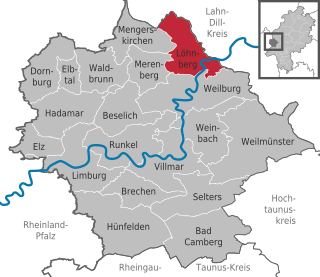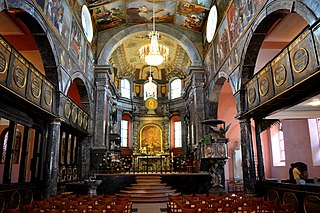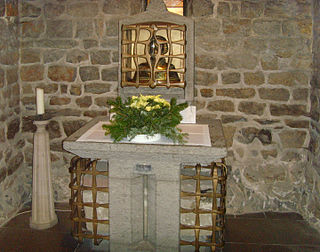
Limburg an der Lahn is the district seat of Limburg-Weilburg in Hesse, Germany.

Lahnstein is a verband-free town of Rhein-Lahn-Kreis in Rhineland-Palatinate, Germany. It is situated at the confluence of the Lahn with the Rhine, approximately 6 kilometres (3.7 mi) south of Koblenz. Lahnstein was created in 1969 by the merger of the previously independent towns of Oberlahnstein on the south side of the Lahn and Niederlahnstein on the north side. In 2020, it had a population of 18,030.

Elz is a municipality in Limburg-Weilburg district in western Hesse, Germany, on the boundary with Rhineland-Palatinate.

Limburg Cathedral (German: Limburger Dom, also known as Georgsdom after its dedication to Saint George, is located above the old town of Limburg in Hesse, Germany. It is the cathedral of the Catholic Diocese of Limburg. Its high location on a rock above the river Lahn provides its visibility from far away. It is the result of an Early Gothic modernization of an originally Early Romanesque building and therefore shows a Romanesque-Gothic transitional style.
The Lords of Eppstein were a family of German nobility in the Middle Ages. From the 12th century they ruled extensive territories in the Rhine Main area from their castle in Eppstein, northwest of Frankfurt, Germany.

Löhnberg is a municipality north of Weilburg in Limburg-Weilburg district in Hesse, Germany.

Hundsangen is an Ortsgemeinde – a community belonging to a Verbandsgemeinde – in the Westerwaldkreis in Rhineland-Palatinate, Germany.

Villmar is a market village and municipality in the Limburg-Weilburg district in Hesse, Germany. The community is the centre for quarrying and processing the so-called Lahn Marble.

The Main-Lahn railway, also called the Limburg railway, is a double-track, electrified main railway line in Germany. The 66.5-kilometer (41.3 mi) long line extends from Frankfurt Central Station (Hauptbahnhof) to Eschhofen, a borough of Limburg an der Lahn.

The Lahngau was a medieval territory comprising the middle and lower Lahn River valley in the current German states of Hesse and (partially) Rhineland-Palatinate. The traditional names of the Gau are Loganahe Pagus or Pagus Logenensis.

Dietkirchen an der Lahn is a borough (Ortsbezirk) of Limburg an der Lahn, seat of the district of Limburg-Weilburg in the state of Hesse, Germany. The formerly independent village was incorporated into Limburg in 1971. The town is dominated by the basilica St. Lubentius, which was the most important early-medieval church building in the region.

The Unionskirche is the active Protestant parish church of Idstein, a town in the Rheingau-Taunus district in the German state of Hesse. Idstein was a residence of the counts of Nassau. The church building in the center of the historic Altstadt dates back to the 14th century when it was built as a collegiate church. It became Lutheran during the Reformation. Its interior was adapted in the 17th century to become a Lutheran Predigt- und Hofkirche. The most prominent decoration in the church is the series of 38 paintings by the Flemish painter Michael Angelo Immenraedt, an exponent of Flemish Baroque painting, and others. They follow a program of biblical scenes.

Rheingauer Dom is the colloquial name for the Catholic parish church in Geisenheim, Germany. Officially Pfarrkirche Heilig Kreuz, the large church in the Rheingau region is called Dom although it was never a bishop's seat. The present building was begun in the 16th century, but major features such as an expansion of the nave from three to five vaults, the towers, the organ and several altars were added in the 19th century. The parish is part of the Diocese of Limburg.

St. Leonhard is a parish of the Roman Catholic Church in Frankfurt, Hesse, Germany. Its historic church dates to 1219, when it was erected in the centre of the town close to the river Main, as a Romanesque-style basilica. From 1425, it was remodeled to a hall church in late Gothic style. St. Leonhard was the only one of nine churches in the Old Town that survived World War II almost undamaged. Today, the parish is part of the Domgemeinde and serves as the parish church of English-speaking Catholics. It is a monument of Frankfurt's history as well as church history and medieval crafts.

Lubentius is a Christian saint, venerated by the Catholic Church. A patron saint of the boatmen on the River Lahn, his feast day is 13 October.

Niederbrechen station is a station on the Main-Lahn Railway, which runs from Frankfurt (Main) Hauptbahnhof to Limburg (Lahn), in the Brechen suburb of Niederbrechen in the German state of Hesse. With Oberbrechen station, it is one of two stations in Brechen. The station is in the network of the Rhein-Main-Verkehrsverbund (RMV) and is classified by Deutsche Bahn as a category 5 station and has three platform tracks.

Marienstatt Abbey is a Cistercian monastery and a pilgrimage site in Streithausen, Westerwaldkreis, Rhineland-Palatinate, in the Nister valley near Hachenburg.

Friedrich Uhlhorn was an honorary professor at the Philipps-Universität Marburg, whose scientific focus was on the history of the State of Hesse and was also known for his work outside Hesse. His special scientific interest was mainly focused on the problems of historical cartography. In collaboration with Edmund Ernst Stengel, he published the Geschichtlichen Atlas von Hessen, which is considered his major work. He also wrote the article Die deutschen Territorien. A: The West, which deals with the West German regional history. Likewise he was responsible as editor for the Hessisches Jahrbuch für Landesgeschichte by Bruno Gebhardt.

The Christuskirche in Walsdorf, now part of Idstein, Hesse, Germany, is a Protestant church built in 1652 to 1663. It restored the structure of an older church which burnt down in 1644 during the Thirty Years' War. It features mainly Gothic architecture with some Romanesque elements, and its interior was fashioned in Baroque style, with a balcony and a ceiling painting. Stained glass windows were added in the 19th century. The church received its name in 1993, 600 years after the mentioning of a chapel. It is a listed building.

St. Bonifatius is a Catholic church in Lorchhausen, part of Lorch, Hesse, Germany. The large church in Gothic revival style was completed in 1879.























